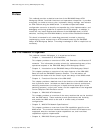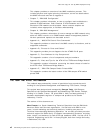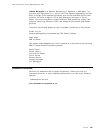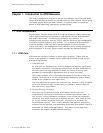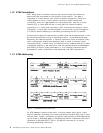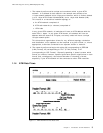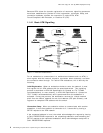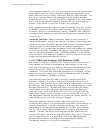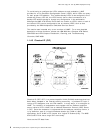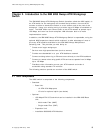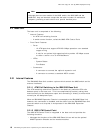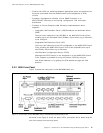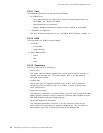This soft copy for use by IBM employees only.
If the requested endstation is not local, the switch will forward the request to the
correct switch based on routing information compiled and maintained by the
8285 ATM Control Point′s Topology and Routing Services (TRS) subsystem. The
path will be selected based on the
widest
path (not the
shortest
) available
between the end-points. This path information is appended to the setup request
and is used by intermediate switches to determine the next hop through the
network. There can be no more than 15 hops in any given path.
If the requested workstation is able to accept the incoming connection, it issues
a CONNECT response to the network, which forwards it back to the requesting
workstation, where it is acknowledged by issuing a CONNECT ACK response to
the network which forwards it to the destination endstation to complete the call
set-up process.
Connection Tear-Down:
When an endstation wishes to end a connection, it
issues a DISCONNECT request to the network. The network acknowledges the
request by returning a RELEASE response (instructing the requesting endstation
to drop all resources associated with the call), and by forwarding the
DISCONNECT on to the destination workstation, which acknowledges the request
by returning a RELEASE command to the network. The process is completed
when the requesting endstation returns a RELEASE COMPLETE to the network,
which forwards it to the destination endstation, indicating that the call has been
dropped and the associated resources freed up.
1.1.4.2 ATM Forum-Compliant LAN Emulation (LANE)
LAN emulation simplifies a migration from a traditional LAN environment to an
ATM switched environment by superimposing LAN interfaces on top of the
underlying ATM transport and by supporting traditional LAN addressing (at the
media access control (MAC) layer) as well as broadcast and multicast
capabilities. This means that LAN-based applications run unchanged, yet now
have access to to the network and to network-attached resources at scalable
speeds from 25 Mbps to 155 Mbps and beyond.
The signalling process used by LANE is analogous to that for basic ATM
signalling, except that instead of a control point providing directory services,
there is now a LAN Emulation Server (LES) which provides directory services at
the MAC layer (which provides MAC address to ATM address mapping) for LAN
Emulation Clients (LECs). The 8285 ATM Control Point has two LES entities,
which together can handle 128 clients, distributed between two Ethernet or
token-ring ELANs. Either of the 8285 ATM Control Point′s two LECs can use
these internal LESs or can be configured to use an external LES, such as the
IBM Multiprotocol Switched Services Server, providing for greater flexibility, for
larger ELANs, and for inter-ELAN routing and bridging.
Emulating a traditional LAN environment requires the ability to allow for
broadcast traffic (common in a connectionless environment), while handling it in
a fashion optimized for a connection-oriented environment. This function is
addressed by the Broadcast/Unknown address Server (BUS), which attempts,
with the LES, to convert MAC broadcast traffic to a specific ATM destination
address. The 8285 ATM Control Point integrates this BUS function with the
internal LES function. Either of the 8285 ATM Control Point′s two LE clients can
also be configured to use an external BUS, such as the IBM Multiprotocol
Switched Services Server, providing for very sophisticated broadcast
management, especially in IP and IPX environments.
Chapter 1. Introduction to ATM Networks 5



